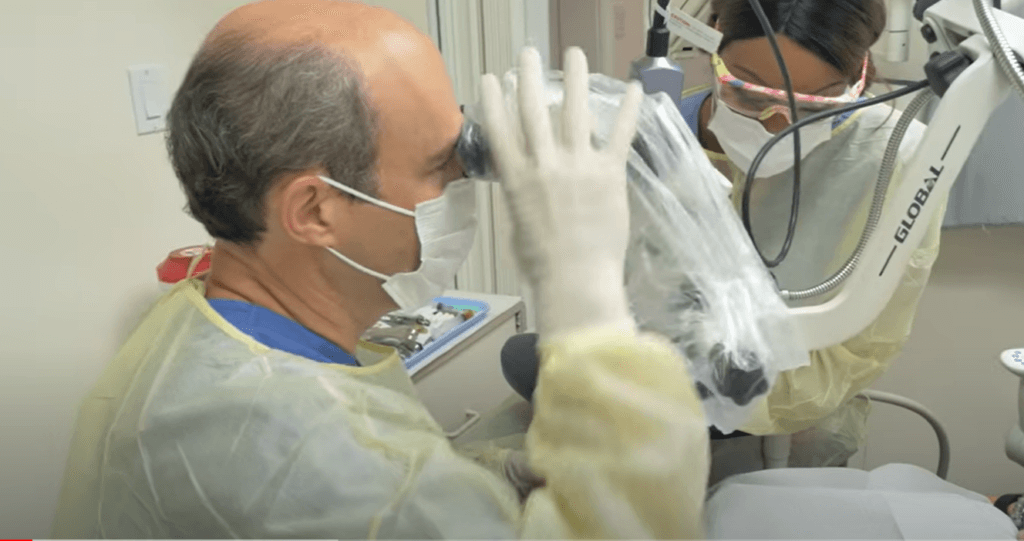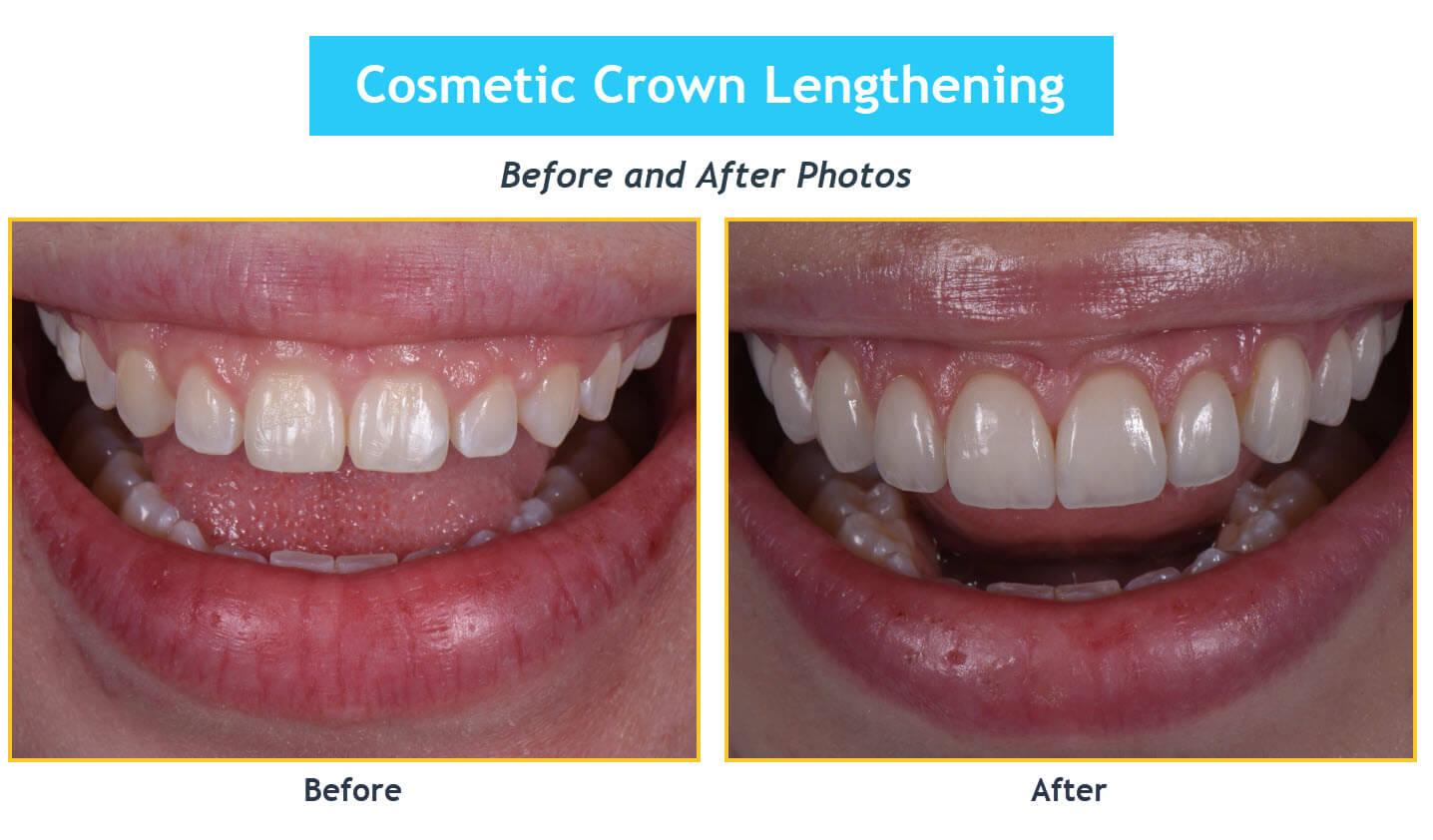As a Manhattan periodontist specializing in periodontal procedures using microsurgery, he has seen firsthand how microsurgical techniques can revolutionize the crown lengthening experience. If you feel self-conscious about your smile because your gums cover too much of your teeth, you may benefit from a crown lengthening procedure performed by Dr Kissel using microsurgical techniques. Let’s explore how microsurgery offers a superior alternative to traditional crown lengthening techniques!
What is Crown Lengthening?
Sometimes a tooth isn’t sufficiently exposed above the gum line, due to factors like genetics or tooth damage. Crown lengthening, also commonly called cosmetic crown lengthening (CCL), reshapes your gums to expose more of your natural teeth. This not only improves the appearance of your teeth resulting in a more beautiful, less gummy smile but it can also make it easier to place a restoration securely. This is because crown lengthening carefully reshapes the gum tissue and sometimes a small amount of bone, creating the space needed for a long-lasting crown, bridge, or other restoration.
If you are still wondering if crown lengthening is for you, here are some of the main benefits:
☑️ It can make your teeth look longer and more proportionate to your face.
☑️ It can enhance the fit and stability of crowns, bridges, or other dental restorations.
☑️ It can prevent tooth decay and gum disease by reducing the amount of plaque and bacteria that can accumulate under the gums.
☑️ It can boost your confidence and self-esteem by giving you a more attractive smile.
The Traditional Crown Lengthening Approach
While effective, traditional crown lengthening can sometimes have downsides when compared with the microsurgical approach:
- More Extensive Tissue Removal: The traditional technique often involves removing larger sections of gum tissue and, in some cases, bone, to expose the desired amount of tooth structure. This can lead to:
- Increased bleeding: More tissue removal naturally involves more blood vessels being affected, potentially leading to heavier bleeding during and after the procedure.
- Longer healing time: Extensive tissue manipulation and removal naturally require a longer healing period for the gums and bone to recover.
- Increased post-operative discomfort: More tissue manipulation and removal can contribute to greater sensitivity and discomfort in the days following surgery.
- Potential for Gum Recession: While the goal is to reshape the gum tissue in a controlled manner, traditional techniques carry a slightly higher risk of unintentional gum recession beyond the desired level. This can lead to:
- Root sensitivity: Exposed tooth root surfaces are more sensitive to hot and cold, potentially causing discomfort.
- Aesthetic concerns: Excessive gum recession can make teeth appear longer and can be aesthetically unappealing.
- Limited Precision: While traditional techniques are effective, they may not offer the same level of precision as microsurgery. This can lead to:
- Uneven gumline: The removal of larger tissue sections might be more challenging to control, potentially leading to a less symmetrical gumline.
- Risk of damaging adjacent teeth or tissues: Less precise control over instruments can increase the risk of unintended damage to surrounding healthy tissue or nearby teeth.
It’s important to note that traditional crown lengthening, when performed by a skilled periodontist, remains a safe and effective procedure. However, the advancements offered by microsurgery provide a gentler and more refined approach, potentially improving the overall patient experience and outcome.
Microsurgery: A More Precise and Minimally Invasive Option
Microsurgery allows for a more refined approach. Here’s how it offers advantages:
- Precision: Dr Kissel uses specialized microsurgical instruments and magnification to work with incredible accuracy. This means less healthy tissue is removed during the procedure.
- Reduced Trauma: Microsurgical techniques are very gentle, leading to reduced swelling and discomfort after the procedure.
- Faster Healing: Because microsurgery is less invasive, patients often enjoy shorter recovery times and faster return to normal activities.
- Aesthetic Outcomes: The meticulous nature of microsurgery helps me achieve natural-looking, symmetrical results, leading to an improved smile aesthetic.

Am I a Candidate for Microsurgical Crown Lengthening?
Microsurgical crown lengthening might be right for you if:
- You have a “gummy smile”: If you feel your smile shows too much gum tissue above your teeth, microsurgery can reshape the gumline for natural-looking results.
- You need a dental restoration: If you require a crown, bridge, or veneer, and insufficient tooth structure is exposed, microsurgery can create the ideal foundation.
- You have tooth decay below the gum line: In some cases, microsurgery allows access to hard-to-reach decay for effective treatment.
Dr Kissel: Your Partner for Exceptional Periodontal Care
Dr Kissel is committed to offering the latest in advanced periodontal treatments. As a dental microsurgery specialist, he has the expertise to provide gentle and effective crown lengthening procedures, leading to faster recovery, optimal comfort, and beautiful, long-lasting results.
If you are considering crown lengthening for restorative or cosmetic reasons, schedule your consultation with Dr Kissel at his Midtown Manhattan periodontal office located between E 52nd St. and E 53rd St.
